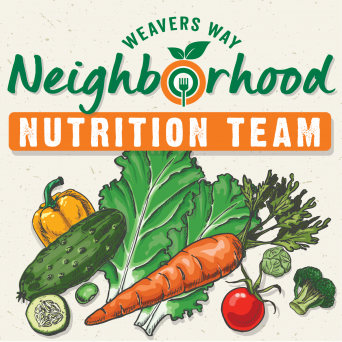
Nutrition Tips for Reducing Allergic Symptoms

THIS MONTH
Learn about the food/allergy connection.
COMING UP IN MAY:
What is gluten? What is “whole” grain? Find out more about the symptoms and prevalence of wheat sensitivity.
RECIPE: Sunflower Herb Dressing
- 2 tbls. fresh thyme or other herbs of your choice
- 1-2 cloves garlic
- ¾ cup chia gel
- ¼ cup pitted olives or organic extra-virgin olive oil
- ½ -1 cup sprouted sunflower or pumpkin seeds
- 1 tbls. lemon or lime juice, apple cider vinegar, water, kefir or kombucha
- 1 tsp. salt
(To make chia gel, put 1-2 tbls. chia seeds in a quart jar, fill with filtered water, give a good shake and let thicken overnight.)
Blend ingredients to desired creaminess and thickness; add more liquid if you like. The beauty of this recipe is how easily it is modified. Enjoy!
bt Dorothy Bauer, Weavers Way Neighborhood Nutrition Team
Having logged many hours at the allergy doctor when my boys were little, I became somewhat of an aficionado on the subject. From elimination diet to rotation diet, I navigated my family to health, wellness and allergic equilibrium. Here’s some of what I learned:
What are the Least Allergenic Foods?
What we eat can have a direct effect on immune-system function, affecting levels of inflammation and histamine in the body. Oftentimes, allergic responses are exacerbated when we’re overloaded with triggers, and diet is an obvious place to start decreasing that burden.
Among the least allergenic foods are lamb and chicken, pears, apricots, apples and cherries. Other good foods are winter squash, sweet potatoes, carrots and asparagus. Choosing organic when possible reduces your intake of pesticides, which can mute the body’s ability to keep antigens (substances that induce an immune response in the body) in check.
Known allergy triggers to avoid include cow’s milk, chicken eggs, peanuts, soy products, wheat, fish and shellfish. Avoid processed food whenever you can — let “fresh is best” be your mantra and guide you to staying healthy.
Fresh Is Best: Greens and Microgreens
Weavers Way Farms’ fabulous spicy greens mix & arugula are in the stores now, affirming that spring is finally around the corner! All the fresh, tender greens are packed with vitality and offer visual and nutritional power to your meals. And microgreens are a real superfood! They’re loaded with a range of health-promoting nutrients for anti-allergy diets or anyone looking to boost the nutritional value of their meals. Microgreens are a tad pricey, but if you consider that 100% of what you are paying for goes on your plates (no stalks or stems to trim) they are well worth it. In addition, the microgreens the Co-op carries are locally grown; the shorter farm-to-plate time ensures higher nutritional integrity and the shorter trip reduces transportation impacts!
Anti-Allergy Salads
What’s your favorite salad? One of my favorite spring time anti-allergy salads (pictured right) contains watermelon radish — as beautiful as they are delicious AND big-time nutritious! Radishes are anti-inflammatory, and they have anti-congestive properties, working to clear your sinuses to help you breathe easier. Jicama is another fabulous addition, with the added benefit of being packed with vitamin C, minerals, folates, pantothenic acid, B vitamins — all nourishing for an allergy-prone body.
Instead of using oil for dressings, I make a lighter, every-bit-as-tasty version using sprouted seeds as the base and chia gel as the carrier, and whatever fresh or dried herbs I have on hand. Here’s the basic recipe. It’s quick, easy and versatile, and will keep in the fridge for about two weeks — not that it ever lasts that long at our house!
